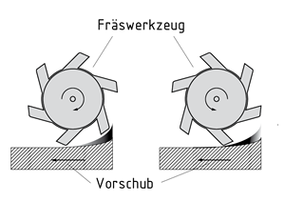
Choose one
or multiple languages
0,1,1
- German
- English
- Chinese
- Spanish
Milling

Milling is a Machining process for solid materials. The rotating milling tool performs the Cutting motion, while the workpiece is clamped in the milling tool's Work table.
During the Forming operation, the work table or milling tool can instigate a feed motion along the X, Y, Z and rotary axes. Program-controlled CNC milling machines control several axes, operating at speeds of up to 100,000 rpm and feed rates of up to 60 m/min. Tools can be stored in automatic tool changers.
Milling can be used to create almost any shape or surface for the workpiece.
Milling processes are categorised by
- The workpiece surface created
- The Kinematics of the cutting process
- The profile of the milling tool
Milling processes also include surface milling, water jet milling, profile milling, form milling and plunge milling. Operators can choose from up-cut and down-cut milling.
Fräsen

Fräsen ist ein spanabhebendes Trennverfahren für feste Werkstoffe. Dabei vollzieht das rotierende Fräswerkzeug die Schnittbewegung, während das Werkstück fest im Maschinentisch der Fräsmaschine eingespannt ist.
Zur Formgebung können Maschinentisch oder Fräswerkzeug Vorschubbewegungen entlang der X-, _x000B_Y-, Z- und der Rotationsachsen ausführen. Programmgesteuerte CNC-Fräsen steuern mehrere Achsen. Sie laufen dabei mit Drehzahlen von bis zu 100.000 U/min und führen Vorschübe bis 60 m/min aus. Werkzeuge können in automatischen Werkzeugwechslern lagern.
Beim Fräsen können fast beliebige Formen und Werkstückoberflächen erzeugt werden.
Eingeteilt werden Fräsverfahren nach
- erzeugter Werkstückoberfläche,
- Kinematik des Zerspanvorgangs,
- Profil des Fräswerkzeugs.
Unterschieden werden auch die Fräsverfahren, zu denen Plan-, Wasserstrahl-, Profil-, Form- oder Tauchfräsen gehören. Eingesetzt werden Gegenlauf- und Gleichlauffräsen.
铣削

铣削是对固体材料的一种机械加工工艺。将工件夹紧在铣刀工作台后,旋转铣刀进行切割运动。
在成型操作过程中,工作台或铣刀可以沿X轴、Y轴、Z轴和旋转轴自由进给运动。程序数控铣床控制多个轴,以高达100,000转速和高达60米/分钟的进给速度运行。刀具可以安装在自动换刀工具中。
铣削可用于加工制造几乎任何形状或表面的工件。
根据以下条件对铣削工艺进行分类
制得的工件表面
切割工艺的运动过程
铣刀的轮廓
铣削工艺还包括面铣、水铣、仿形铣削、成形铣削和插铣。操作者可以选择逆洗和顺铣。
逆洗和顺铣
Fresado

El fresado es un proceso de maquinado para materiales sólidos. La herramienta de fresado rotativo lleva a cabo el movimiento de corte, mientras que la pieza de trabajo es sujetada al banco de trabajo de la fresadora.
Durante la operación de conformado, el banco de trabajo o la fresadora pueden instigar un movimiento de alimentación a lo largo de los ejes X, Y, Z y rotativos. Las fresadoras CNC controladas por programas controlan varios ejes, operando a velocidades de hasta 100,000 rpm y con tasas de alimentación de hasta 60 m/min. Las herramientas pueden almacenarse en intercambiadores de herramientas automáticos.
El fresado puede usarse para crear casi cualquier forma o superficie para la pieza de trabajo.
Los procesos de fresado se clasifican según:
La superficie de la pieza de trabajo creada
La cinemática del proceso de corte
El perfil de la fresadora
Los procesos de fresado también incluyen el fresado de superficie, fresado por chorro de agua, fresado de perfil, fresado para forma y fresado por inmersión. Los operadores pueden elegir entre el fresado de corte hacia arriba o de corte hacia abajo.
Fresado de corte hacia arriba y de corte hacia abajo
